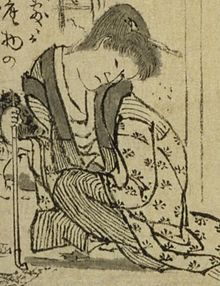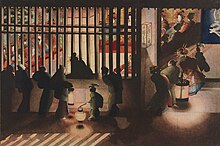Katsushika Ōi
Katsushika Ōi (葛飾 応為) | |
|---|---|
 Katsushika Ōi in the mid-1840s | |
| Born | c. 1800 (exact date unknown) |
| Died | c. 1866 (exact date unknown) |
| Nationality | Japanese |
| Known for | Ukiyo-e |
| Father | Hokusai |


Katsushika Ōi (葛飾 応為, c. 1800 – c. 1866), also known as Ei[1] (栄) or Ei-jo,[2] was a Japanese Ukiyo-e artist of the early 19th century Edo period. She was a daughter of Hokusai from his second wife. Ōi was an accomplished painter who also worked as a production assistant to her father.[3][4]
Biography
[edit]Ōi's birth and death dates are not known, although it is believed that she was born in 1800 and died around 1866.[2] She was a daughter of the ukiyo-e artist Katsushika Hokusai (1760—1849).[5][6] Hokusai was married twice; the first marriage[a] produced a son and two daughters, and the second, to a woman named Kotome (ことめ), resulted in a son and one or two daughters.[7]
Ōi studied her craft under her father's guidance as his apprentice. She also studied under Tsutsumi Torin III (1789–1830) who was a fellow painter and printmaker. This is where she met Minamizawa Tomei (also known as Tsutsumi Tōmei), another one of Tsutsumi Torin III's students,[2] and married him in 1824.[8] Their marriage did not last long, for only three years later they divorced. It is rumored that their marriage ended as a result of Ōi's criticism of Minamizawa Tomei's work, claiming he was a terrible artist, and laughing at him for it.[8] Ōi thereafter went to live with her father again, and assisted Hokusai with his artwork, and took to producing her own as well. In 1828, Kotome, Ōi's mother died, leaving her to care for her now sixty year old father.[8] Neither of them cared about housework or maintaining their home, with all their time occupied by their work, both of them painting and printmaking alongside one another in an unkempt household.[8]
Despite her father's fame, Ōi too managed to make a name for herself. In Hokusai's family, his daughters were expected to tend to their father and assist him in his workshop until they were married off and required to tend to their own husbands.[8] While Ōi's sisters, Miyo, Tatsu, and Nao, all suffered this fate, Ōi never remarried, allowing her to move back in and work on her craft.[8]
Hokusai himself noted his daughters' talent when it came to depicting beautiful women, remarking on her technique as forces to be reckoned with, forces he himself could not compete with.[8] Other artists at the time like Keisai Eisen regarded her as accomplished, for despite being a woman, Ōi garnered a reputation as a skillful artist after her father.[8]
Works
[edit]Ōi is known to have excelled at handwriting and in bijin-ga paintings of beautiful women. The following is a selected list of her works.
- Kinuta or Beauty Fulling Cloth in the Moonlight (date unknown) – Single-sheet woodblock print. Tokyo National Museum collection.
- Yoshiwara Night Scene (date unknown) – The parts of her name can be observed in this scene, distributed over three different lanterns tagged with symbols "O", "i", and "Ei". Ukiyo-e Ōta Memorial Museum of Art collection.
- Kuruwa in Grid View (date unknown) – Ukiyo-e Ōta Memorial Museum of Art collection.
- Beauty of Spring Night (date unknown) – Menard Art Museum collection.
- Hundred Eyes (date unknown) – Hokusai Museum collection.
- Mount Fuji through a Bamboo Forest (date unknown) – Hanging scroll; ink and color on silk. Hokusai Museum collection.
- Three Women Playing Musical Instruments (c. 1818–1844, i.e. Bunsei to Tenpō era) – Hanging scroll; ink and color on silk. Museum of Fine Arts, Boston, collection.
- Operating on Guanyu's Arm (c. 1818–1854) – Hanging scroll; ink, color and gold leaf on silk. – Cleveland Museum of Art collection.

- One Thousand Years of Hyakunin isshu Yamato Longevity (1829)[3] – Pictorial.
She has also been credited as an illustrator for the following books.
- Illustrated Handbook for Daily Life for Women (1847) – Woodblock printed book. Ravicz Collection.[9]
- A Concise Dictionary of Sencha (1848)[10]
Aside from drawing and painting, Ōi also made keshi ningyō dolls and sold them to earn a living.[11]
Legacy
[edit]This section needs expansion. You can help by adding to it. (June 2016) |
Few of Ōi's works are known: amongst them, a few nikuhitsu-ga paintings, the illustrations to the book Onna Chōhō-ki (女重宝記, 1847) by Takai Ranzan (高井 蘭山), and no prints.[5]
Canadian novelist Katherine Govier wrote a first-person novel about Ōi titled The Ghost Brush (2010,[12] also titled The Printmaker's Daughter).[13]
The story of Ōi was adapted to comics as Miss Hokusai (1983–1987), which had an animated movie adaptation in 2015. The story tells of the outspoken O-Ei, daughter of the famed artist Tetsuzō, for whom she sometimes paints uncredited. The film won numerous awards.[14]
Makate Asai based her novel Kurara on the life of Ōi; it was published in 2016 after serialization in 2014–15, and an NHK television adaptation of it titled Kurara: Hokusai no Musume ("Kurara: Hokusai's Daughter") appeared in 2017, starring Aoi Miyazaki.[15]
Notes
[edit]References
[edit]- ^ "葛飾, 応為 カツシカ, オウイ" (in Japanese). CiNii. Retrieved May 22, 2017.
- ^ a b c "Collections Online | British Museum". www.britishmuseum.org. Retrieved 2022-04-04.
- ^ a b Katsushika Ōi (1829). Senzai Hyakunin isshu yamato-kotobuki 千歳百人 一首倭寿.
- ^ Machotka, Ewa (2009). Visual Genesis of Japanese National Identity: Hokusai's Hyakunin Isshu. Peter Lang. ISBN 978-90-5201-482-1.
- ^ a b Kamiya 2006, p. 116.
- ^ Morrill, Rebecca; Elderton, Louis; Wright, Karen (2019). Great Women Artists. Phaidon Press. p. 210. ISBN 978-0714878775.
- ^ a b Suzuki 2016, p. 188.
- ^ a b c d e f g h "Hokusai and Ōi: art runs in the family - British Museum Blog". British Museum Blog - Explore stories from the Museum. Retrieved 2022-04-04.
- ^ Fister, Pat (1988). Japanese women artists, 1600–1900. Yamamoto, Fumiko Y., Helen Foresman Spencer Museum of Art., Honolulu Academy of Arts. (1st ed.). Lawrence: Spencer Museum of Art, University of Kansas. ISBN 9780913689257. OCLC 17682726.
- ^ Kobayashi Tadashi and Julie Nelson Davis. "The Floating World in Light and Shadow: Ukiyo-e Paintings by Hokusai's Daughter Oi". in Carpenter, J. T. et al (eds). Hokusai and his age: Ukiyo-e painting, printmaking and book illustration in late Edo Japan. Amsterdam: Hotei Publishing. 2005.
- ^ Fister, Pat (1988). Japanese women artists, 1600–1900. Yamamoto, Fumiko Y., Helen Foresman Spencer Museum of Art., Honolulu Academy of Arts. (1st ed.). Lawrence: Spencer Museum of Art, University of Kansas. ISBN 9780913689257. OCLC 17682726.
- ^ Hanrahan 2010.
- ^ Tanabe 2011.
- ^ "Director Keiichi Hara Wins Asiagraph 2015 Tsumugi Prize for Miss Hokusai Film". Anime News Network. August 11, 2015. Archived from the original on 2015-10-20. Retrieved October 19, 2015.
- ^ 日本放送協会, 眩(くらら)〜北斎の娘〜 (in Japanese), retrieved 2022-03-12
Bibliography
[edit]- Hanrahan, Catherine (2010-05-28). "Review: Fiction: Under the Great Wave". The Globe and Mail. Retrieved 2016-06-17.
- Kamiya, Hiroshi (2006). "Katsushika Ōi". In Kobayashi, Tadashi (ed.). Ukiyo eshi retsuden 浮世絵師列伝. Bessatsu Taiyō (in Japanese). Heibonsha. p. 116. ISBN 978-4-582-94493-8.
- Suzuki, Yukiko (2016). Ukiyo-e no Onna-tachi 浮世絵の女たち [Women of Ukiyo-e] (in Japanese). Gentosha. ISBN 978-4-344-02950-7.
- Tanabe, Kunio Francis (2011-12-26). "Book World: Art and artifice in Katherine Govier's Printmaker's Daughter". The Washington Post. Retrieved 2016-06-17.
External links
[edit] Media related to Katsushika Ōi at Wikimedia Commons
Media related to Katsushika Ōi at Wikimedia Commons

